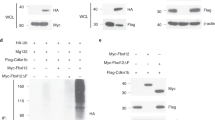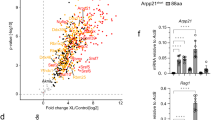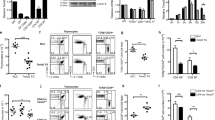Abstract
The adaptor molecule SLAP and E3 ubiquitin ligase c-Cbl each regulate expression of T cell receptor (TCR)–CD3 on thymocytes. Here we provide genetic and biochemical evidence that both molecules function in the same pathway. TCR-CD3 expression was similar in the absence of SLAP and/or c-Cbl. SLAP and c-Cbl were found to interact, and their expression together downregulated CD3ε. This required multiple domains in SLAP and the ring finger of c-Cbl. Furthermore, expression of SLAP and c-Cbl together induced TCRζ ubiquitination and degradation, preventing the accumulation of fully assembled recycling TCR complexes. These studies indicate that SLAP links the E3 ligase activity of c-Cbl to the TCR, allowing for stage-specific regulation of TCR expression.
This is a preview of subscription content, access via your institution
Access options
Subscribe to this journal
Receive 12 print issues and online access
$209.00 per year
only $17.42 per issue
Buy this article
- Purchase on Springer Link
- Instant access to full article PDF
Prices may be subject to local taxes which are calculated during checkout






Similar content being viewed by others
References
Love, P.E. & Chan, A.C. Regulation of thymocyte development: only the meek survive. Curr. Opin. Immunol. 15, 199–203 (2003).
Finkel, T.H., McDuffie, M., Kappler, J.W., Marrack, P. & Cambier, J.C. Both immature and mature T cells mobilize Ca2+ in response to antigen receptor crosslinking. Nature 330, 179–181 (1987).
Havran, W.L. et al. Expression and function of the CD3-antigen receptor on murine CD4+8+ thymocytes. Nature 330, 170–173 (1987).
Kearse, K.P., Roberts, J.P., Wiest, D.L. & Singer, A. Developmental regulation of αβ T cell antigen receptor assembly in immature CD4+CD8+ thymocytes. Bioessays 17, 1049–1054 (1995).
Myers, M., Dragone, L.D. & Weiss, A. Src-like adaptor protein down-regulates T cell receptor (TCR)/CD3 expression by targeting TCRζ for degradation. J. Cell Biol. 170, 285–294 (2005).
Pandey, A., Duan, H. & Dixit, V.M. Characterization of a novel Src-like adapter protein that associates with the Eck receptor tyrosine kinase. J. Biol. Chem. 270, 19201–19204 (1995).
Roche, S. et al. Src-like adaptor protein (SLAP) is a negative regulator of mitogenesis. Curr. Biol. 8, 975–978 (1998).
Sosinowski, T., Pandey, A., Dixit, V.M. & Weiss, A. Src-like adaptor protein (SLAP) is a negative regulator of T cell receptor signaling. J. Exp. Med. 191, 463–474 (2000).
Tang, J., Sawasdikosol, S., Chang, J.H. & Burakoff, S.J. SLAP, a dimeric adapter protein, plays a functional role in T cell receptor signaling. Proc. Natl. Acad. Sci. USA 96, 9775–9780 (1999).
Naramura, M., Kole, H.K., Hu, R.J. & Gu, H. Altered thymic positive selection and intracellular signals in Cbl-deficient mice. Proc. Natl. Acad. Sci. USA 95, 15547–15552 (1998).
Sosinowski, T., Killeen, N. & Weiss, A. The Src-like adaptor protein downregulates the T cell receptor on CD4+CD8+ thymocytes and regulates positive selection. Immunity 15, 457–466 (2001).
Donovan, J.A., Wange, R.L., Langdon, W.Y. & Samelson, L.E. The protein product of the c-cbl protooncogene is the 120-kDa tyrosine-phosphorylated protein in Jurkat cells activated via the T cell antigen receptor. J. Biol. Chem. 269, 22921–22924 (1994).
Rao, N., Dodge, I. & Band, H. The Cbl family of ubiquitin ligases: critical negative regulators of tyrosine kinase signaling in the immune system. J. Leukoc. Biol. 71, 753–763 (2002).
Joazeiro, C.A. et al. The tyrosine kinase negative regulator c-Cbl as a RING-type, E2-dependent ubiquitin-protein ligase. Science 286, 309–312 (1999).
Weissman, A.M. Regulating protein degradation by ubiquitination. Immunol. Today 18, 189–198 (1997).
Cenciarelli, C. et al. Activation-induced ubiquitination of the T cell antigen receptor. Science 257, 795–797 (1992).
Cenciarelli, C., Wilhelm, K.G., Jr., Guo, A. & Weissman, A.M. T cell antigen receptor ubiquitination is a consequence of receptor-mediated tyrosine kinase activation. J. Biol. Chem. 271, 8709–8713 (1996).
Hou, D., Cenciarelli, C., Jensen, J.P., Nguygen, H.B. & Weissman, A.M. Activation-dependent ubiquitination of a T cell antigen receptor subunit on multiple intracellular lysines. J. Biol. Chem. 269, 14244–14247 (1994).
Wang, H.Y. et al. Cbl promotes ubiquitination of the T cell receptor ζ through an adaptor function of Zap-70. J. Biol. Chem. 276, 26004–26011 (2001).
Azzam, H.S. et al. CD5 expression is developmentally regulated by T cell receptor (TCR) signals and TCR avidity. J. Exp. Med. 188, 2301–2311 (1998).
Merkenschlager, M. et al. How many thymocytes audition for selection? J. Exp. Med. 186, 1149–1158 (1997).
Kane, L.P., Lin, J. & Weiss, A. Signal transduction by the TCR for antigen. Curr. Opin. Immunol. 12, 242–249 (2000).
Negishi, I. et al. Essential role for ZAP-70 in both positive and negative selection of thymocytes. Nature 376, 435–438 (1995).
Kadlecek, T.A. et al. Differential requirements for ZAP-70 in TCR signaling and T cell development. J. Immunol. 161, 4688–4694 (1998).
Thien, C.B., Bowtell, D.D. & Langdon, W.Y. Perturbed regulation of ZAP-70 and sustained tyrosine phosphorylation of LAT and SLP-76 in c-Cbl-deficient thymocytes. J. Immunol. 162, 7133–7139 (1999).
Heuser, J.E. & Anderson, R.G. Hypertonic media inhibit receptor-mediated endocytosis by blocking clathrin-coated pit formation. J. Cell Biol. 108, 389–400 (1989).
Daukas, G. & Zigmond, S.H. Inhibition of receptor-mediated but not fluid-phase endocytosis in polymorphonuclear leukocytes. J. Cell Biol. 101, 1673–1679 (1985).
Telerman, A. et al. Internalization of human T lymphocyte receptors. Eur. J. Immunol. 17, 991–997 (1987).
Dallanegra, A., Schaffar, L., Breittmayer, J.P., Carpentier, J.L. & Fehlmann, M. Effect of hypertonicity and monensin on CD3/TCR surface expression in human T cells. Immunol. Lett. 19, 115–120 (1988).
Naramura, M. et al. c-Cbl and Cbl-b regulate T cell responsiveness by promoting ligand-induced TCR down-modulation. Nat. Immunol. 3, 1192–1199 (2002).
Irving, B.A. & Weiss, A. The cytoplasmic domain of the T cell receptor ζ chain is sufficient to couple to receptor-associated signal transduction pathways. Cell 64, 891–901 (1991).
Qian, D., Mollenauer, M.N. & Weiss, A. Dominant-negative ζ-associated protein 70 inhibits T cell antigen receptor signaling. J. Exp. Med. 183, 611–620 (1996).
van Oers, N.S., Killeen, N. & Weiss, A. ZAP-70 is constitutively associated with tyrosine-phosphorylated TCRζ in murine thymocytes and lymph node T cells. Immunity 1, 675–685 (1994).
Crotzer, V.L., Mabardy, A.S., Weiss, A. & Brodsky, F.M. T cell receptor engagement leads to phosphorylation of clathrin heavy chain during receptor internalization. J. Exp. Med. 199, 981–991 (2004).
Bachmaier, K. et al. Negative regulation of lymphocyte activation and autoimmunity by the molecular adaptor Cbl-b. Nature 403, 211–216 (2000).
Chiang, Y.J. et al. Cbl-b regulates the CD28 dependence of T-cell activation. Nature 403, 216–220 (2000).
Miura-Shimura, Y. et al. Cbl-mediated ubiquitinylation and negative regulation of Vav. J. Biol. Chem. 278, 38495–38504 (2003).
Fang, D. & Liu, Y.C. Proteolysis-independent regulation of PI3K by Cbl-b-mediated ubiquitination in T cells. Nat. Immunol. 2, 870–875 (2001).
Loreto, M.P., Berry, D.M. & McGlade, C.J. Functional cooperation between c-Cbl and Src-like adaptor protein 2 in the negative regulation of T-cell receptor signaling. Mol. Cell. Biol. 22, 4241–4255 (2002).
Holland, S.J. et al. Functional cloning of Src-like adapter protein-2 (SLAP-2), a novel inhibitor of antigen receptor signaling. J. Exp. Med. 194, 1263–1276 (2001).
Pandey, A. et al. A novel Src homology 2 domain-containing molecule, Src-like adapter protein-2 (SLAP-2), which negatively regulates T cell receptor signaling. J. Biol. Chem. 277, 19131–19138 (2002).
Andoniou, C.E. et al. The Cbl proto-oncogene product negatively regulates the Src-family tyrosine kinase Fyn by enhancing its degradation. Mol. Cell. Biol. 20, 851–867 (2000).
Sanjay, A. et al. Cbl associates with Pyk2 and Src to regulate Src kinase activity, αvβ3 integrin-mediated signaling, cell adhesion, and osteoclast motility. J. Cell Biol. 152, 181–195 (2001).
Tsygankov, A.Y., Mahajan, S., Fincke, J.E. & Bolen, J.B. Specific association of tyrosine-phosphorylated c-Cbl with Fyn tyrosine kinase in T cells. J. Biol. Chem. 271, 27130–27137 (1996).
Goldsmith, M.A. & Weiss, A. Isolation and characterization of a T-lymphocyte somatic mutant with altered signal transduction by the antigen receptor. Proc. Natl. Acad. Sci. USA 84, 6879–6883 (1987).
Straus, D.B. & Weiss, A. Genetic evidence for the involvement of the lck tyrosine kinase in signal transduction through the T cell antigen receptor. Cell 70, 585–593 (1992).
Williams, B.L. et al. Genetic evidence for differential coupling of Syk family kinases to the T-cell receptor: reconstitution studies in a ZAP-70-deficient Jurkat T-cell line. Mol. Cell. Biol. 18, 1388–1399 (1998).
Yablonski, D., Kuhne, M.R., Kadlecek, T. & Weiss, A. Uncoupling of nonreceptor tyrosine kinases from PLC-γ1 in an SLP-76-deficient T cell. Science 281, 413–416 (1998).
Rao, N. et al. The linker phosphorylation site Tyr292 mediates the negative regulatory effect of Cbl on ZAP-70 in T cells. J. Immunol. 164, 4616–4626 (2000).
Rao, N. et al. The non-receptor tyrosine kinase Syk is a target of Cbl-mediated ubiquitylation upon B-cell receptor stimulation. EMBO J. 20, 7085–7095 (2001).
Ota, S. et al. The RING finger domain of Cbl is essential for negative regulation of the Syk tyrosine kinase. J. Biol. Chem. 275, 414–422 (2000).
Acknowledgements
We thank F. Brodsky, M. von Zastrow and members of the Weiss lab for comments and suggestions. Supported by the National Institutes of Health (CA72531 to A.W. and CA987986 to H.B.).
Author information
Authors and Affiliations
Corresponding author
Ethics declarations
Competing interests
The authors declare no competing financial interests.
Supplementary information
Supplementary Fig. 1
CD3ε internalization by DP thymocytes is normal in the absence of SLAP and/or c-Cbl. (PDF 184 kb)
Rights and permissions
About this article
Cite this article
Myers, M., Sosinowski, T., Dragone, L. et al. Src-like adaptor protein regulates TCR expression on thymocytes by linking the ubiquitin ligase c-Cbl to the TCR complex. Nat Immunol 7, 57–66 (2006). https://doi.org/10.1038/ni1291
Received:
Accepted:
Published:
Issue Date:
DOI: https://doi.org/10.1038/ni1291
This article is cited by
-
Role of SRC-like adaptor protein (SLAP) in immune and malignant cell signaling
Cellular and Molecular Life Sciences (2015)
-
SLAP displays tumour suppressor functions in colorectal cancer via destabilization of the SRC substrate EPHA2
Nature Communications (2014)
-
LAPTM5 promotes lysosomal degradation of intracellular CD3ζ but not of cell surface CD3ζ
Immunology & Cell Biology (2014)
-
SLAP deficiency increases TCR avidity leading to altered repertoire and negative selection of cognate antigen-specific CD8+ T cells
Immunologic Research (2013)
-
Slap
AfCS-Nature Molecule Pages (2011)



